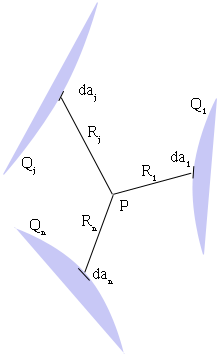Coefficients of potential
Topic: Physics
 From HandWiki - Reading time: 3 min
From HandWiki - Reading time: 3 min
In electrostatics, the coefficients of potential determine the relationship between the charge and electrostatic potential (electrical potential), which is purely geometric:
- [math]\displaystyle{ \begin{matrix} \phi_1 = p_{11}Q_1 + \cdots + p_{1n}Q_n \\ \phi_2 = p_{21}Q_1 + \cdots + p_{2n}Q_n \\ \vdots \\ \phi_n = p_{n1}Q_1 + \cdots + p_{nn}Q_n \end{matrix}. }[/math]
where Qi is the surface charge on conductor i. The coefficients of potential are the coefficients pij. φi should be correctly read as the potential on the i-th conductor, and hence "[math]\displaystyle{ p_{21} }[/math]" is the p due to charge 1 on conductor 2.
- [math]\displaystyle{ p_{ij} = {\partial \phi_i \over \partial Q_j} = \left({\partial \phi_i \over \partial Q_j} \right)_{Q_1,...,Q_{j-1}, Q_{j+1},...,Q_n}. }[/math]
Note that:
- pij = pji, by symmetry, and
- pij is not dependent on the charge.
The physical content of the symmetry is as follows:
- if a charge Q on conductor j brings conductor i to a potential φ, then the same charge placed on i would bring j to the same potential φ.
In general, the coefficients is used when describing system of conductors, such as in the capacitor.
Theory

System of conductors. The electrostatic potential at point P is [math]\displaystyle{ \phi_P = \sum_{j = 1}^{n}\frac{1}{4\pi\epsilon_0}\int_{S_j}\frac{\sigma_j da_j}{R_{j}} }[/math].
Given the electrical potential on a conductor surface Si (the equipotential surface or the point P chosen on surface i) contained in a system of conductors j = 1, 2, ..., n:
- [math]\displaystyle{ \phi_i = \sum_{j = 1}^{n}\frac{1}{4\pi\epsilon_0}\int_{S_j}\frac{\sigma_j da_j}{R_{ji}} \mbox{ (i=1, 2..., n)}, }[/math]
where Rji = |ri - rj|, i.e. the distance from the area-element daj to a particular point ri on conductor i. σj is not, in general, uniformly distributed across the surface. Let us introduce the factor fj that describes how the actual charge density differs from the average and itself on a position on the surface of the j-th conductor:
- [math]\displaystyle{ \frac{\sigma_j}{\langle\sigma_j\rangle} = f_j, }[/math]
or
- [math]\displaystyle{ \sigma_j = \langle\sigma_j\rangle f_j = \frac{Q_j}{S_j}f_j. }[/math]
Then,
- [math]\displaystyle{ \phi_i = \sum_{j = 1}^n\frac{Q_j}{4\pi\epsilon_0S_j}\int_{S_j}\frac{f_j da_j}{R_{ji}}. }[/math]
It can be shown that [math]\displaystyle{ \int_{S_j}\frac{f_j da_j}{R_{ji}} }[/math] is independent of the distribution [math]\displaystyle{ \sigma_j }[/math]. Hence, with
- [math]\displaystyle{ p_{ij} = \frac{1}{4\pi\epsilon_0 S_j}\int_{S_j}\frac{f_j da_j}{R_{ji}}, }[/math]
we have
- [math]\displaystyle{ \phi_i=\sum_{j = 1}^n p_{ij}Q_j \mbox{ (i = 1, 2, ..., n)}. }[/math]
Example
In this example, we employ the method of coefficients of potential to determine the capacitance on a two-conductor system.
For a two-conductor system, the system of linear equations is
- [math]\displaystyle{ \begin{matrix} \phi_1 = p_{11}Q_1 + p_{12}Q_2 \\ \phi_2 = p_{21}Q_1 + p_{22}Q_2 \end{matrix}. }[/math]
On a capacitor, the charge on the two conductors is equal and opposite: Q = Q1 = -Q2. Therefore,
- [math]\displaystyle{ \begin{matrix} \phi_1 = (p_{11} - p_{12})Q \\ \phi_2 = (p_{21} - p_{22})Q \end{matrix}, }[/math]
and
- [math]\displaystyle{ \Delta\phi = \phi_1 - \phi_2 = (p_{11} + p_{22} - p_{12} - p_{21})Q. }[/math]
Hence,
- [math]\displaystyle{ C = \frac{1}{p_{11} + p_{22} - 2p_{12}}. }[/math]
Related coefficients
Note that the array of linear equations
- [math]\displaystyle{ \phi_i = \sum_{j = 1}^n p_{ij}Q_j \mbox{ (i = 1,2,...n)} }[/math]
can be inverted to
- [math]\displaystyle{ Q_i = \sum_{j = 1}^n c_{ij}\phi_j \mbox{ (i = 1,2,...n)} }[/math]
where the cij with i = j are called the coefficients of capacity and the cij with i ≠ j are called the coefficients of electrostatic induction.[1]
For a system of two spherical conductors held at the same potential,[2]
- [math]\displaystyle{ Q_a=(c_{11}+c_{12})V , \qquad Q_b=(c_{12}+c_{22})V }[/math]
[math]\displaystyle{ Q =Q_a+Q_b =(c_{11}+2c_{12}+c_{bb})V }[/math]
If the two conductors carry equal and opposite charges,
- [math]\displaystyle{ \phi_1=\frac{Q(c_{12}+c_{22})}{{(c_{11}c_{22}-c_{12}^2)}} , \qquad \quad \phi_2=\frac{-Q(c_{12}+c_{11})}{{(c_{11}c_{22}-c_{12}^2)}} }[/math]
[math]\displaystyle{ \quad C =\frac{Q}{\phi_1-\phi_2}= \frac{c_{11}c_{22} - c_{12}^2}{c_{11} + c_{22} + 2c_{12}} }[/math]
The system of conductors can be shown to have similar symmetry cij = cji.
References
- ↑ L. D. Landau, E. M. Lifshitz, and L. P. Pitaevskii, Electrodynamics of Continuous Media (Course of Theoretical Physics, Vol. 8), 2nd ed. (Butterworth-Heinemann, Oxford, 1984) p. 4.
- ↑ Lekner, John (2011-02-01). "Capacitance coefficients of two spheres". Journal of Electrostatics 69 (1): 11–14. doi:10.1016/j.elstat.2010.10.002.
- James Clerk Maxwell (1873) A Treatise on Electricity and Magnetism, § 86, page 89.
 |
 KSF
KSF